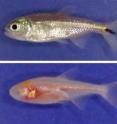Adapting to darkness: How behavioral and genetic changes helped cavefish survive extreme environment
University of Maryland biologists have identified how changes in both behavior and genetics led to the evolution of the Mexican blind cavefish (Astyanax mexicanus) from its sighted, surface-dwelling ancestor. In research published in the August 12, 2010 online edition of the journal Current Biology, Professor William Jeffery, together with postdoctoral associates Masato Yoshizawa, and Špela Gorički, and Assistant Professor Daphne Soares in the Department of Biology, provide new information that shows how behavioral and genetic traits coevolved to compensate for the loss of vision in cavefish and to help them find food in darkness. This is the first time that a clear link has been identified between behavior, genetics, and evolution in Mexican blind cavefish, which are considered an excellent model for studying evolution. Why Study Blind Cave Fish
Worldwide, about 80 different species of cave-dwelling fish have evolved from surface-dwelling fish, but in most cases the surface-dwelling ancestor has disappeared. "The Mexican blind cavefish is one of the only cases where a similar ancestor still exists," explains Professor Jeffery. "Except for the loss of eyes and pigment seen in the cave-dwelling form, the surface and cave-dwellers are hard to tell apart. You can study evolution very nicely if you have both the ancestral and derived forms of evolving animals."
Jeffery is a leading expert on the developmental and evolutionary genetics of the blind cavefish. His previous research provided evidence that the loss of eyes in blind cavefish is the result of natural selection, and has inspired other researchers to take up Astyanax as a model system for studying eye loss and evolution in general. Studying the evolution of cave fish may help provide clues about human forms of blindness such as macular degeneration and cataracts, and the University of Maryland team is also exploring how studies of cave fish metabolism might be used to better understand the underlying causes of obesity and diabetes in humans. "It turns out that many of the mutations in genes studied in model organisms like Astyanax are the same genes that are involved in human disease," says Jeffery. "By studying evolution, you can see what sort of mutations and genes are present in the population and how these can be selected for or against."
Linking Behavior, Genetics, and Evolution
Jeffery's research team showed how an adaptive behavior found in blind cavefish that gives them an advantage in locating food in the dark is linked to a genetic trait. "Vibration Attraction Behavior" (or VAB) is the ability of fish to swim toward the source of a water disturbance in darkness. Postdoctoral associate Masato Yoshizawa measured this behavioral response in both wild caught and laboratory raised cave and surface-dwelling fish using a vibrating rod at different frequencies as a stimulus. Most cavefish displayed VAB and would swim toward the vibrating rod and poke at it, while few surface fish did.
This behavior is advantageous for feeding success in the dark caves where food sources are limited and large predators are absent. "Outside the cave, however, there are many predators," explains Jeffery, "and indiscriminately going to a vibration would be a certain risk for predation for a surface-dwelling fish."
The cavefish responded most frequently and strongly to a vibration at a frequency of 35 Hz. "This frequency falls within the range that is detected by the superficial neuromasts," explained Yoshizawa. "These specialized hair cells are part of the fish's lateral line, which is the sensory organ used to detect movement and vibration in the surrounding water."
To confirm the role of the superficial neuromasts (SN) and the lateral line, Yoshizawa measured the VAB after he inhibited the function of the superficial neuromasts in both cavefish and surface fish. "I used a non-toxic glue on their cheek region, and then released them in the water. This glue then peeled off from their skin as they moved in the water, and removed the superficial neuromast hair cells, or at least reduced their sensing ability," explains Yoshizawa. "You can imagine that it is kind of like waxing your legs."
Without the sensing ability of the SN, the cavefish no longer exhibited the VAB, while the surface dwelling fish did not exhibit any more or less VAB. The team went on to explore the role that the number and size of the SN played in VAB, as the cave dwelling fish have more and larger SN cells and were the most likely to exhibit the adaptive behavior. Yoshizawa made a genetic cross between the surface fish and the cave dwelling fish to get a hybrid species. The cave dwelling fish, who have more and larger superficial neuromast (SN) cells, were most likely to exhibit the adaptive behavior. The hybrid fish showed an intermediate number of neuromasts and also exhibited an intermediate vibration attraction behavior reaction -- more than the surface fish, but less than the cave fish.
From this, the research team concluded that the VAB and SN enhancement coevolved to compensate for loss of vision and to help blind cavefish find food in darkness. This study adds important new information about how Mexican blind cavefish have adapted to their extreme environment through evolutionary changes. The next step in this research will be to identify the gene or genes involved in VAB, which offers the exciting possibility of understanding this behavioral shift at the molecular level.
Source: University of Maryland
Other sources
- Adapting to darkness: How behavioral and genetic changes helped cavefish survive extreme environmentfrom Science DailyWed, 15 Sep 2010, 3:21:36 UTC
- Adapting to darkness: How behavioral and genetic changes helped cavefish survive extreme environmentfrom Science BlogTue, 14 Sep 2010, 21:56:17 UTC
- Adapting to darkness: How behavioral and genetic changes helped cavefish survive extreme environmentfrom PhysorgTue, 14 Sep 2010, 21:21:22 UTC
